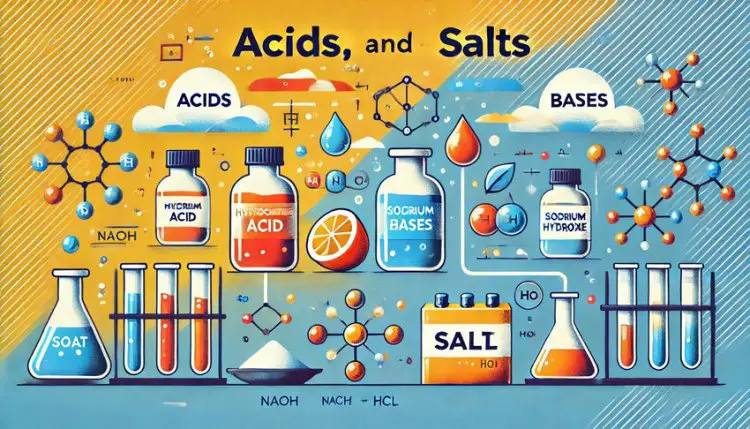Acids, Bases, and Salts
Acids, bases, and salts are fundamental concepts in chemistry, playing a crucial role in various scientific and industrial applications. This article provides an in-depth look at their definitions, properties, types, and uses. Acids: Substances that donate protons (H+), characterized by their sour taste and ability to turn blue litmus paper red. Examples include hydrochloric acid, sulfuric acid, and acetic acid. Bases: Substances that accept protons (H+) or donate electron pairs, characterized by their bitter taste and slippery feel. Examples include sodium hydroxide, calcium hydroxide, and ammonium hydroxide. Salts: Ionic compounds formed by the neutralization reaction between an acid and a base, consisting of positive ions (cations) from the base and negative ions (anions) from the acid. Examples include sodium chloride, calcium carbonate, and potassium nitrate. This guide covers the properties, types, and applications of acids, bases, and salts, including their importance in ind

Understanding acids, bases, and salts is fundamental in chemistry, and it plays a crucial role in various scientific and industrial applications. This article provides a comprehensive look at their definitions, properties, types, and uses.
1. Acids
Definition:
Acids are substances that can donate a proton (H+) to another substance and have a pH less than 7. They are characterized by their sour taste and ability to turn blue litmus paper red.
Properties:
- Taste: Sour
- pH: Less than 7
- Reaction with Metals: Acids react with metals to produce hydrogen gas. For example:
- Electrical Conductivity: Acids conduct electricity in aqueous solutions due to the presence of ions.
- Corrosive: Strong acids can be highly corrosive, damaging materials and living tissue.
- Litmus Test: Turns blue litmus paper red.
Examples:
- Hydrochloric Acid (HCl): Found in stomach acid, used in cleaning and processing.
- Sulfuric Acid (H2SO4): Used in car batteries and manufacturing fertilizers.
- Acetic Acid (CH3COOH): Found in vinegar, used in food preservation and flavoring.
Types of Acids:
- Organic Acids: Derived from living organisms. Example: Citric acid, acetic acid.
- Inorganic Acids: Not derived from living organisms. Example: Hydrochloric acid, sulfuric acid.
- Strong Acids: Completely ionize in solution. Example: Hydrochloric acid, sulfuric acid.
- Weak Acids: Partially ionize in solution. Example: Acetic acid, citric acid.
2. Bases
Definition:
Bases are substances that can accept a proton (H+) or donate an electron pair in reactions. They have a pH greater than 7 and are characterized by their bitter taste and slippery feel.
Properties:
- Taste: Bitter
- pH: Greater than 7
- Reaction with Acids: Bases neutralize acids to form water and salt. For example:
- Electrical Conductivity: Bases conduct electricity in aqueous solutions due to the presence of ions.
- Caustic: Strong bases can be caustic, capable of causing chemical burns.
- Litmus Test: Turns red litmus paper blue.
Examples:
- Sodium Hydroxide (NaOH): Used in soap making and drain cleaners.
- Calcium Hydroxide (Ca(OH)2): Used in plaster and cement.
- Ammonium Hydroxide (NH4OH): Used in cleaning agents and fertilizers.
Types of Bases:
- Strong Bases: Completely ionize in solution. Example: Sodium hydroxide, potassium hydroxide.
- Weak Bases: Partially ionize in solution. Example: Ammonium hydroxide, calcium hydroxide.
3. Salts
Definition:
Salts are ionic compounds formed by the neutralization reaction between an acid and a base. They consist of positive ions (cations) from the base and negative ions (anions) from the acid.
Properties:
- Taste: Can vary, but many are salty.
- Solubility: Many salts are soluble in water, but solubility can vary.
- Electrical Conductivity: Salts conduct electricity in molten state or in aqueous solution.
- Crystalline Structure: Most salts form crystalline structures.
Examples:
- Sodium Chloride (NaCl): Common table salt, used in food seasoning and preservation.
- Calcium Carbonate (CaCO3): Found in limestone, used in construction and as an antacid.
- Potassium Nitrate (KNO3): Used in fertilizers and gunpowder.
Types of Salts:
- Normal Salts: Formed by the complete neutralization of an acid by a base. Example: Sodium chloride.
- Acid Salts: Formed by the partial neutralization of a diprotic or triprotic acid. Example: Sodium bisulfate.
- Basic Salts: Formed by the partial neutralization of a base. Example: Basic lead carbonate.
Applications and Importance
- Acids: Acids play a critical role in industrial processes, food preservation, and digestion. For example, sulfuric acid is essential in manufacturing fertilizers and refining petroleum.
- Bases: Bases are vital in soap and detergent production, paper making, and many chemical synthesis processes.
- Salts: Salts are used extensively in food seasoning, preservation, and various industrial applications such as manufacturing glass, ceramics, and fertilizers.
Understanding acids, bases, and salts is fundamental to mastering chemistry, as they are involved in a wide range of chemical reactions and industrial processes. Their unique properties and interactions are central to many scientific and practical applications.
What's Your Reaction?


















